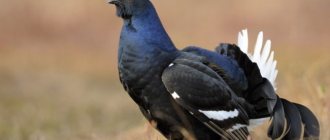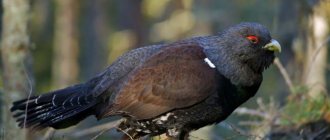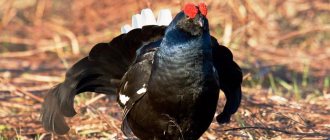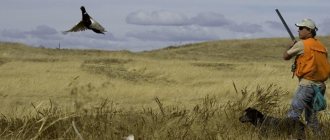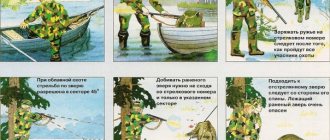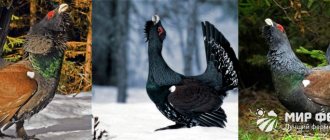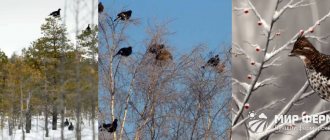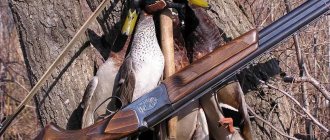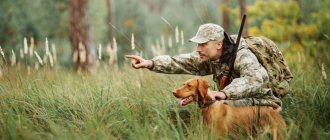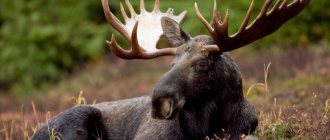The black grouse in Russia is one of the beautiful birds that is a desirable prey for hunters, as well as photography lovers. The grouse lek is a beautiful sight, you need to see it with your own eyes. If you meet the morning in a forest where grouse currents pass, the impressions of this will remain with you for the rest of your life. Photographers take pictures of black grouse mainly in the spring at the mating area. However, not all hunters and photographers know how to find a lek and in what places to look for a mower.
Typically, black grouse live in birch groves, on the edges of forests, in overgrown clearings, in river valleys, in sparse forests with berries, and in burnt areas. In those places where there are leks in swamps among tall forests, black grouse stay in the old forest, in clearings and swamps. Orcas do not take root in dark forests and move to other places.
How grouse leks are prepared
In the fall, when the leaves fall, the orcas gather in flocks and live together all winter. With the onset of spring warmth, black grouse begin a completely different life. Large flocks created for winter begin to separate, males move away from females. At this time, having fed on birch buds, the orcas begin to mutter while on the tree branches. When it gets warmer, moose whales display even more actively, sitting on trees near the grouse lek. This time is called the beginning of the black grouse current. They descend down to the ground, where the main spectacle begins.
The peak of the current season occurs during the period when the first paths in the forest thaw and the fields open up to snow. For black grouse, the weather does not matter much, unlike wood grouse. At the height of the mating season, killer whales can conduct mating games in the cold and wind. But the most favorable weather for this is calm and cloudless.
It is not difficult to detect grouse leks. He independently notifies the nearby area about this. When grouse mutter, their sounds can be heard several kilometers away. If in a given area there are grouse in the spring in the spring, or broods of grouse in the summer or winter, then you can look for a grouse lek in this place. Local residents can help in this matter. The population now has a lot of technology. People drive through the forest, looking for grouse leks all day, listening to the voices of birds and marking different places. If you are sure that there may be a current source in a certain place, you should look for it there. Finding a grouse lek in a known area is much faster than wandering through unfamiliar copses.
Using decoy
Experienced hunters know well that the song of a mower at a leking site begins with a kind of “chuffing”. Making these sounds, the bird begins to jump quite high. After such an original introduction, the “muttering” begins.
Hunting for grouse with a decoy is based on a person’s ability to imitate the sounds made by grouse at the lek, as well as the calling cries of grouse or the noise of a flock landing on trees. Luring is used primarily when it is impossible to get close to a game sitting on a branch or showing for a sure shot.
What time to look for grouse leks
You should start searching for currents in March, on hard snow, when it gets warmer. At such a time in the morning at dawn, after feeding on birch catkins, the orcas begin to make sounds while in the trees. A black grouse sitting on a branch can be heard and even seen from afar. Starting in the morning, when the sun has risen, it is necessary to walk around the nearby territory and note in which places the kosaki sing in the trees. The lek has not yet been created, and the black grouse sing one at a time. During such a period, it is necessary to understand where in the area there are more whales that are in the trees.
If the male is alone, he is simply a solitary singer. If there are several of them, and they sing nearby, then a current source will be located nearby. It's good to have binoculars with you. It will help you to see the current of kosher whales from afar and to study the area of the current without scaring the birds. Sometimes, when visibility is insufficient, when it is impossible to approach without making noise, it is better to climb a tree to accurately determine the location of the males’ mating.
Clean forest edges, meadows overgrown with bushes and trees, copses, arable lands, moss swamps, burnt areas and deforestation - in such areas, killer whales always hang out. The size of the current is usually small. At the beginning of mating games, males sing at dawn. At their peak, they begin their songs even in the dark, when the sun has not yet risen. At the height of this period, males may sing in the evening, but this spectacle is short-lived. It is not advisable to look for a lek in the evening; it is difficult and only scares the birds.
Grouse current: hunting for scythes before and now
Hunters can still catch a streamer on a lek. Relatively recently, widespread hunting is becoming increasingly inaccessible, but fortunately it still exists. The essence of this process, interesting in all respects, of tracking and catching orca whales has remained the same, but some features due to changes in nature have become different. Of course, first of all, those fabulous numbers of roosters that were observed everywhere just a few decades ago have disappeared forever. The behavior of birds has also changed. They are constantly trying to adapt to rapidly changing living conditions. For example, black grouse survived global reclamation and now arrange their love games on drained peatlands. Based on reports from various observers, the author tried to compare previous lek hunts with current ones. Perhaps this will be of interest not only to hunters, but also to opponents of spring hunting, who stubbornly strive to limit it, or even ban it completely.
Such “greenies” constantly insist that one should not raise a gun at a bird engaged in love games, and unfoundedly try to blame the hunters for the depletion of land. They, who have never tried to delve into the mysteries of the life of wild animals, do not understand that the removal of a certain percentage of individuals of a certain species contributes to the vitality of the rest of the population. And it’s best to do this at a time when you can slowly point the gun not only at an extra male, but precisely at one that has already been culled by nature itself, and who is unlikely to be able to leave healthy offspring. In addition, you can never take many birds on a grouse lek.
“Spring shooting of black grouse is neither prey nor easy,” wrote Aksakov, who, however, did not know the shooting of black grouse or black grouse at leks from huts. In the steppe Orenburg province, he hunted black grouse from the approach or entrance. It is even more difficult to get many birds from one hut.
Aksakov is echoed by L.P. Sabaneev, who taught contemporary hunters how to achieve greater success, warning that there is never a lot of prey on a lek.
“Under no circumstances should you visit the same current for more than two mornings in a row. It’s best to shoot on it first every other day, then after two, three or even more, but in general, on rare occasions, hunting can be successful even the third time.”
There is no doubt that in the 19th century it was not difficult to catch several birds in a morning. According to Aksakov, the birds in certain places chose their mating habitat and “... it takes constant human effort to force the black grouse to abandon it and choose another one. Even for several years in a row, currents occur in the same places.”
It is clear that in this case it is much easier to prepare a shelter for the shooter in advance and from it to catch the killer whales throughout the mating season. The task was also simplified because the current location was most often located near trees and bushes.
“This can either be a clear clearing in the forest, or a meadow between trees growing at the edge and sometimes standing in an open field, mainly on a hillock.”
Even near one tree or bush it is always easier to place a hut that is unnoticeable to birds.
At present, many naturalists and hunters notice that black grouse almost daily change the location of the current within some vast area suitable for these purposes. Moreover, they will not return to their original place if they notice any change on it - the shelter installed the day before.
At the same time, you very often see forest birds displaying in forest areas in completely open areas, far from shelters in the form of trees and bushes. This especially applies to solitary whales. And single currents are also observed more and more often. I remember how, having left the huts and having very few birds at dawn, we were teased, almost in broad daylight, by one or the other Orca, enthusiastically mating on the almost endless arable land, choosing the highest point on it.
It can be assumed that the abundance of feathered predators (their main enemies during this period) in former times forced black grouse to arrange their games near places where they could hide. Now, when, undoubtedly, the number of feathered enemies has decreased significantly, black grouse feel more at ease away from shelters, under the cover of which an animal or a person can get close to them. By the way, Sabaneev also noted that near populated areas, where black grouse are often disturbed and their numbers are small, the black grouse display alone. But then they chose not open places.
“Each mower mutters, having chosen a small forest clearing or lawn among bushes and small forests, and only occasionally does his closest neighbor come running to him along the forest paths in response to his voice.”
As for the frequent change of lekking location, some hunters in Russia have adapted to this by mastering a new method of lek hunting. A. Sinitsyn told about this in the hunting press.
According to his observations, “... each lek has, as it were, its own mating area with an area of approximately one square kilometer, and in this area there are from three to five mating sites. Orcas don’t change their area, but they change places quite often.”
He is confident that it is more effective to hunt “wandering” leks not in the “classical” way, but in the “simplified” way. Such a hunt is possible “... at the height of the currents, when the orcas fly out to the lek very early, almost at night, and its meaning is as follows: in complete darkness I go to the lek, scare the orcas, take the simplest shelter... and with prey!”
The calculation is based on the fact that in advance, based on the first sounds, the location of the birds is approximately determined. Scared in the dark, they usually return to their old place at dawn, and there a hunter is waiting for them, often hidden only under a simple camouflage blanket in the form of a cape. According to A. Sinitsyn, he never had a case where the scythes, driven away in the dark, did not return.
Aksakov, a great connoisseur of hunting and game birds, also drew attention to the numerical ratio of birds of different sexes at leks: “There are always much fewer hens than oscalves, and sometimes there is one female for many males.”
This is another argument in favor of the validity of removing excess males. In addition, on leks it is easy to spot individuals that are unnecessary for reproduction. According to the observations of hunters, at each lek there is about one or so moose whale - the most active one, who finds an equal in strength and arranges a tournament in the fight for females. The rest cling to the edge of the lek and display sluggishly - these are either young or weak males. It is these that the cultural hunter gets, without causing any harm to the gene pool. And it’s not difficult to distinguish the killer whales from each other if you don’t rush to shoot and give yourself the opportunity to observe to your heart’s content. This is how L.P. wrote. Sabaneev: “The ones who try the most are the oldest, brightest-browed kosakis—the currents, who consider themselves complete masters of the current; They scurry around everywhere, colliding with the first enemy they encounter, driving away weak and young males that have only recently arrived to the outskirts of the breeding ground.”
Considering the small number of lek hunting enthusiasts, it becomes clear that they are in no way the reason for the decline in the number of grouse. The same applies to an even smaller number of hunters who hunt them in the summer-autumn season with a pointing dog.
It seems that these forest birds can withstand even constant disturbance from people not related to hunting, but it is difficult for them to make up for real losses in numbers from many reasons. Perhaps, it is hunters who could save the black grouse from the greatest damage, but many bureaucratic prohibitions do not allow them to effectively reduce the number of foxes, raccoon dogs, crows, and ravens, which en masse kill not only game birds, but all birds in a row.
Hunting on leks will remain one of the most interesting from the point of view of the hunter-naturalist, who, having enjoyed a rare spectacle, appreciating the number of birds, their differences, only “at the end” will allow himself a shot to rejoice at the amazing trophy - a red-browed bird in black and white feathers .
How to find the place of the current
During such a hunt, the main task is to detect the middle of the current in order to correctly install the hut. In the first half of the flight, the birds are already descending from the trees to the ground, and traces of the scythes can be seen in the snow near the lekking site. But based on such signs, it is too early to draw conclusions about the location of the lek. During such a period, the scythes can make broods and sing songs far from the current. When large thawed patches appear on the lekking area, the orcas will gather in their favorite place.
It is very difficult to find out where the middle of the current is. It is necessary to inspect the area where the hunters saw the displaying males. The center of the current is most often located in an elevated place. Usually this is a flat place without bumps. During the inspection, you need to pay attention to the presence of droppings, feathers and fluff that remain after fights between the orcas. In the area where there are more feathers and droppings, there is the middle of the current. Leks are usually found in the same place every year, regardless of location. The center of the current can move slightly, but rarely completely changes its location. An exception may be destructive hunting or constant alarm of birds.
At some leking grounds, males begin to display next to the leking area, and not in the place itself. At first they are single males, then after dawn they move to the main place. It happens that the current is floating. Every day, killer whales can move around the mating area, and it is not possible to determine its center. The lek can become scattered, but when females visit it, the orcas gather in flocks in one place, where the main spectacle takes place, and fierce fights between the orcas occur.
How to find a lek in the spring
The black grouse is a fairly constant bird. From year to year he chooses the same place for mating. Therefore, if you are not lazy, it will be quite easy to find it. After all, the sounds made by the killer whales can sometimes be heard a kilometer or more away. The main condition for active grouse mating is good spring weather. This bird, like all chickens, does not like rainy, windy days. On clear, quiet mornings, her mating is very active. Moreover, night frosts stimulate it even more.
In the spring you need to go out in search of a lek at dawn. You need to walk without making sudden movements and, if possible, avoiding open places. Showing birds are very careful: they can take off, sensing a person located at a distance of two hundred meters or even further. It is not advisable to scare them away, since subsequently the birds will be very careful on it.
How does the grouse current pass?
Grouse appear on the lek at its height - this is mid-April. In the most active areas of the current, the grass is trampled down by the end of the month. Using these signs, you can find the middle of the current. Often each male on the lek has his own place where he sings his song and protects it from his rivals. Young males do not have an individual place and are located on the edge of the lek. There is a statement regarding the presence of a kind of “lekking” at a lek—a male who appears here first and determines the pace of mating. Hunters say that it is incorrect to claim the presence of such a “current agent” in one number. Surely, there are several mature dominant males at the mating site who display the most active mating.
The peak of the current occurs on clear days. In April, when the evenings are warm, orcas can display in the evening. In March and the beginning of the next month, mating usually ends after the celestial body rises. In mid-April, when the current is in full swing, males can display until 10 a.m., but their activity decreases. If the males are not disturbed, they can stay on the lek or near it all day. The grouse currents end later than the capercaillie mating displays - at the end of May. Most often, adult males no longer sing by mid-May, but young individuals can still display until the end of May.
How to find a grouse lek
The black grouse is one of our most beautiful birds, a coveted trophy of hunters and animal photographers.
And the grouse lek itself is an incredibly beautiful action that you definitely need to see with your own eyes. It’s worth spending just one morning at a grouse lek to gain impressions for the rest of the year, or even your whole life. Anamal photographers take pictures of black grouse mainly in the spring on the lek. But how to find a grouse lek ? In what places to look for black grouse, and where are currents most often found? So, let's take it in order...
The characteristic habitats of black grouse are birch groves that alternate with fields, forest edges, small groves and copses, open forests with an abundance of berries, valleys of large rivers, overgrown clearings and burnt areas. In the area where there are currents in moss swamps in the middle of a tall forest, the black grouse tries to stay in the copses between tracts of old forest, along overgrown clearings, burnt areas and the edges of swamps covered with young forest. As a rule, black grouse avoid dense dark forests.
In the fall, as soon as all the leaves have fallen, black grouse gather in flocks and spend the whole winter like this. With the first spring thaws, the way of life of black grouse changes. Large winter flocks begin to break up, and the black grouse separate from the grouse. At this time in the morning, having eaten birch buds, black grouse begin to quietly mutter while sitting in the trees. With the onset of warm days, the black grouse begin to display more actively, and other moos begin to respond to the chuffing and muttering. At this time, black grouse actively display, sitting on trees near the place of permanent display. This is the beginning of the current. But the real current will begin when the earth is almost exposed and spring streams are actively flowing. Then the black grouse descend from the trees to the ground, where the main action takes place.
The peak of the currents occurs at the time when the first extensive thawed patches appear in the forest, and the fields are almost completely free of snow. The weather for the black grouse is not as important as for the wood grouse - at the height of the currents, roosters can display both in the wind and in the frost. But the best weather is calm and clear.
Finding a grouse lek is not difficult - it announces itself to the surrounding area. The muttering of black grouse on a quiet, windless morning can be heard two kilometers away, and the chuffing (hissing) sound can be heard half a kilometer away. If you have seen kosher whales in this area in the spring, or broken grouse broods in the summer or winter, it is advisable to go in search of this area. Questioning local non-hunters often helps. With the active “motorization” of the population, many search for currents in this way: they drive through promising areas from dawn to sunrise during the current period, listening to black grouse and noticing places. Of course, if you know the search area and are confident that there may be a current there, you need to start searching there. Finding a grouse lek in a familiar area is much easier than wandering through unfamiliar places.
You can start looking for current in March, on the crust, with the onset of the first warm days. On such days, in the mornings at sunrise, black grouse, having eaten birch catkins, begin to mutter while sitting in the trees. A kosach sitting on a tree can be heard and seen from afar. Early in the morning, as the sun rises, you need to walk around the promising territory and notice in which places the orcas are singing in the trees. There is no current as such yet, and black grouse are still displaying alone. At this time, it is necessary to determine in which part of the study area there are the most black grouse sitting on trees. If there is only one black grouse, then it is most likely a lone singer. If there are several killer whales, and they are mating in trees not far from each other, then somewhere in this area there will be a mating area. Binoculars will be useful when searching for currents - with their help you can see the current grouse from afar and study the location of the current without disturbing the birds. Sometimes, if visibility is poor and it is impossible to approach silently, it can even be useful to climb a tree in order to more accurately determine where exactly the killer whales are mating.
A clean edge of the forest, meadows slightly overgrown with bushes and trees, dry manes in the forest, copses between forest islands, moss swamps, arable lands, clearings or burnt areas that are beginning to overgrow - in such places, from time immemorial, black grouse have been mating. The area of the current, as a rule, is small, unless it is a huge current of several tens of braids (such currents are rare in our time). At the beginning of the currents, the black grouse sing with the sunrise. At the height of the song they begin to sing in the dark, long before dawn. At the height of the currents, black grouse also display evening displays, but this is usually short-lived, and it is not recommended to search for the current in the evening, as it is quite difficult and you can disturb the birds.
On such a hunt, the most important thing is to find the center of the current in order to successfully set up a hut. In early to mid-March, black grouse already begin to descend to the ground, and their tracks can be found in the snow in the area of leks. But from these traces it is too early to judge the center of the current. At this time, black grouse can leave dams and wander on the ground away from the current, and only when extensive thawed areas appear in the current (field, swamp or clearing) do the black grouse begin to gather in their favorite place. Determining the center of the current is always more difficult. It is necessary to carefully inspect the area where black grouse were seen showing. The center of the current is usually located at the highest point of the site; this can be a flat area where there are not many hummocks. When inspecting the area, you need to carefully look at your feet - look for droppings and the consequences of grouse fights: down and feathers. In the place where there is the most droppings and feathers, there is the center of the current. Currents, as a rule, appear in the same place from year to year (be it a corner of a field, a moss or peat bog, or a plot near a forest). The center of the current may shift slightly, but rarely changes location (unless the current is actively disturbed or is being hunted for destruction).
At some leks, black grouse begin to display not at the lek itself, but nearby. First alone, then at dawn they fly to the main current. It happens that the current is “floating”. Black grouse move around the current area day after day, and there is no so-called current center here. The current may be scattered, but when black grouse begin to visit it, the roosters cluster in a certain area, where the most important action takes place and fierce fights break out between the roosters. Grouse appear on the lek at the height of the currents - usually in mid-April. In active lekking areas, by the end of April, the grass is trampled, and from such “spots” the center of the lek can also be determined. Often, each lekking moose has its own area in which it leks and which protects it from rivals. In this case, the “youth” usually do not have their own areas and remain on the periphery of the current. There is a common opinion about the presence of a so-called “lekking” at the lekking site - a black grouse, which arrives very first and “sets the pace of mating.” According to the observations of numerous hunters, it is still incorrect to talk about the lek in the singular. Rather, there are several mature dominant males at the lek, who are the ones who lek most actively.
The most violent currents occur in clear weather. In April, with the onset of warm evenings, black grouse can display in the evening. In March and early April, the current usually ends at sunrise. In mid-April, at the height of the currents, black grouse can display until 9-10 o'clock in the morning, although the activity of displaying noticeably decreases at this time. If the roosters are not disturbed, they can spend the entire day on the lek or in close proximity to it. Grouse leks end later than wood grouse – after mid-May. As a rule, adult roosters stop singing by the end of the first half of May, and young birds can continue mating until the end of the month.
Happy photo hunting. I wish everyone who is looking to find their current and get a lot of impressions and great shots! And don’t forget to take a navigator with you to mark the location of the current on the map, and also not to get lost in the forest if you are looking for a current in a wooded area.
PS You can also find useful information in the article “Grouse Hunting”.
Setting up a hut or tent
The current is large, sometimes reaching several hectares. Therefore, you need to choose the right place for the hut. Then we can talk about a successful hunt. The middle of the lek is determined by the feathers and droppings of the scythes that appeared after fights. The hut should be placed near this place. Usually, old hunters install a hut on a lek in advance so that the males get used to it. But this is not always confirmed. Sometimes you can set up a hut just before the hunt and catch a killer whale in the morning. The main condition is to make the hut in such a way that it is not visible, to camouflage it with the external environment.
If there are bushes or trees near the middle of the current, they should be used as the base of the hut. The males get used to them; the nearby hut does not cause alarm. You need to make a hut from materials that are nearby, to which the mowers are accustomed. If you set up a hut in a field with withered grass and sparse bushes and cover it with spruce paws, this will scare away the birds, and they will fly away to continue mating.
Black grouse display mainly in open places: clearings, meadows, edges, and fields. It is easy to find; the muttering of males can be heard several kilometers away. The hut is usually made from young trees or bushes. Trunks or branches 2 meters long, about 5 cm thick, are suitable. One end is sharpened and driven into the ground. The ends at the top are tied with twine or rope. The hut is made in the form of a haystack or haystack. Next, small branches are applied to the branches of the frame, which cover the sides and bottom of the hut. The final stage is laying the pieces of hay on the walls. You can take it with you or use the stacks nearby.
You can use last year's grass. She needs to line the walls of the hut, leaving only small windows open for shooting. Inside the hut the ground is covered with hay for a comfortable stay in it. The entrance to the hut should be made small, on the opposite side to the current. It is camouflaged with hay, regardless of whether hunting is taking place at a given time or not. The hut should be spacious, since the hunter has to sit in it for several hours, this time spent should be comfortable.
Hunting for black grouse on a lek - how to build a hut
A hut for hunting black grouse on a lek is built during the day so that the birds do not notice the presence of a person on the lek. On perennial leks known to the hunter, huts are erected a week or two before the start of the hunting season. In this case, the black grouse get used to the unusual structure and can display very close by.
To build a hut, they usually choose a flat, dry place and make a frame in a circle - young trees and stakes cut down at a distance and pointed at the bottom are stuck into the ground. If the ground is still frozen, holes are punched to install this frame, or to strengthen it, each tree is secured with stepsons, tied to a driven peg. The poles and trees are placed vertically, not conically: this will make the hut more spacious. Cone huts for hunting grouse on a lek are easier to set up, but they must be large enough. I saw such conical huts that Yaroslavl hunters made from fir trees; they were so huge that you could freely stand up to your full height in them without touching the ceiling.
The hut is usually braided with spruce or pine spruce branches, which it is advisable to attach to the frame with aluminum wire. This need is associated with strong winds, which often occur in the spring, as a result of which the hut can be deformed. It is not advisable to correct it in the morning, immediately before the hunt. Several branches are usually strengthened horizontally from above and braided with spruce branches to form a roof. But many hunters recommend leaving the top open, so that in case of a miss they have the opportunity to fire a second shot. Quite often geese can swoop in (I’ve also had such cases - I was returning from a levy with a goose). In addition, sometimes it happens like this: in the dark, until full dawn, black grouse dart close to the hut, and when dawn breaks, they fly away and become inaccessible for a reliable shot. This usually happens on the first morning after installing the hut on the current. In this case, there is one way out: if it is not yet light enough, slowly rise up in the hut and shoot from above. But still, experience suggests that black grouse often fly low over a hut, and if they notice a hunter in it, they may not fly close. Black grouse and even black grouse themselves often land on a dense hut with a roof, and if there is no roof, they fly away in panic. The constructed hut must be disguised to match the color of the surrounding background. If black grouse are mating in copses where there are small pines or fir trees, no special camouflage is required. If in a swamp, clearing or open field, the hut is camouflaged with last year’s grass, or, if found, with hay. It must be woven quite tightly, it is better to tie it. At the end of all this work, a floor is made of spruce branches and loopholes are cut for shooting. You also need to take care of the seat, since sitting on the ground, even on a thick layer of spruce branches, is not only cold and unsafe for health, but also uncomfortable - your legs quickly become numb. It’s better to use a folding chair (fishermen’s chairs are very convenient), and if you don’t have one, use a fairly tall log of wood, which you can find in the nearest clearing. True, to shoot, sometimes you have to move the seat to the side and kneel.
You need to dress very warmly for this hunt. I remember one of the famous hunting writers said that the coldest place on earth is a hut on a grouse trench. And indeed it is. Even when hunting with a decoy you don’t get as cold as here. If the hut is far from home or a hunting base and there is a long journey ahead, you need to walk lightly so as not to sweat, and take all your warm clothes with you. If it’s freezing in the morning, a winter hat, warm mittens and even felt boots won’t hurt.
Hunting for black grouse on a lek video
Setting up a hut or tent
A narrow and small hut will be uncomfortable. Instead of sheltering on a lek, you can use a fishing tent made of green tarpaulin, without a floor, with windows on three sides, and a folding frame made of duralumin. This type of tent can be set up quickly, it is lightweight and the orcas are not afraid of it. The tent is invisible on the ground; hunters have already shot many black grouse from such tents. You need to come to the hut early, when the black grouse have not yet appeared on the mating area. Otherwise, frightened birds will not fly to the current. Clothing when hunting is also of great importance. In April there are frosts in the morning and at night. Therefore, clothes should be warm and spacious. You can lay some fabric on top of the hay, or put clothes on it. Feet also need to be insulated, they are the first to freeze. Shoes should be comfortable and warm.
Hunting from a hut
Poor visibility in the morning makes it difficult to calculate the distance to birds. Therefore, you need to stick branches into the ground in advance at a gunshot distance. There is no point in shooting at scythes located further than such branches; there will be a miss or a wounded bird. Black grouse appear on the current in the dark and descend to the ground with the noisy flapping of their wings. Then the birds begin to mutter. Active games, the current lasts until sunrise. Then the birds fall silent. With the first rays, the current gains strength, and fights begin. This is the right moment to shoot the streamer, which at such a moment has lost its caution.
It is necessary to slowly stick the barrel of the weapon out the window of the hut, take aim when the scythe is motionless, and shoot. If the shot was accurate, the bird remains in place. If she flew away, you need to see if she fell. If after this the black grouse sits near the current, it is a wounded bird. We need to remember this place and explore it after the hunt. When shooting, you need to make sure that females do not fall under the gun. They usually arrive at the lek before sunrise and sit until the end. The feathers camouflage the female on the grass or ground and are more difficult to see than the kosher. Therefore, when observing from a hut, it is better to use binoculars.
Black grouse is a tenacious bird. The gun must have a sharp and compact action. When hunting from a hut, it is better to use a single-barreled shotgun with a compact fire than a double-barreled shotgun. Usually shooting is carried out at medium and short distances. They rarely shoot at long distances. At such distances, shot No. 3 or No. 4 is usually used. For long-range shooting, cartridges with No. 2 shot are used. It is recommended to aim at the side of the grouse; shots at the tail or crop will only injure the bird.
It is necessary to pick up shot black grouse after the end of the mating period, when there are no birds. It is necessary to comply with shooting standards, not to kill more than a fifth of the killer whales. The breeding grounds now mainly consist of a dozen roosters, so there is an unspoken rule - do not kill more than one rooster in one breeding area in the spring. The culinary properties of spring rooster meat are low. It is better to make a stuffed animal out of the shot bird, which will remind you of the grouse mating that took place in April.
Grouse hunting
Grouse hunting
Hunting for grouse in the spring current
Hunting for grouse in the spring current is considered one of the most interesting
sport hunting. During the grouse lek, which lasts about two months, there is a certain order that ensures that the strongest males leave offspring. The center of the current is occupied by one or two to four of the strongest roosters, which differ noticeably in size, long tail lyres, and energetic chatter. These are roosters aged 4-5 years or more. Around them are roosters of 2-3 years of age, which still have brown feathers on their upper wing coverts. Each lekking male has his own permanent area on the lekking area, which he protects from the invasion of neighbors. One-year-old roosters usually sit on the outskirts of the lek. Sometimes one of them tries to penetrate the lek, but is energetically driven out by the adult roosters.
Places for currents
Birds choose places for leks in winter fields or fallows, forest edges, forest glades, semi-open forest swamps, slopes and other open places. In populated areas, black grouse breed alone or in small groups of 3-5 roosters. In remote places you can still find leks consisting of 20-40 roosters or more. On some Siberian leks, up to 200 singing black grouse gather. Black grouse begin to lek in early spring. The first currents are short in duration and small in number in terms of the number of displaying roosters. Males flock 2-3 hours before sunrise. The first to arrive is the old kosach and, making sure that the situation is calm, they begin to display. At this time, the killer whales usually display while sitting in the trees; At the same time, young roosters do not take part in mating, but only watch the old men sing. But gradually more and more birds begin to display. Roosters move to the ground, gather in large groups and form so-called leks. Each rooster circles with a song in his area, spreading his perpendicularly raised tail like a fan and lowering his wings. Sometimes neighboring males fight fiercely among themselves, then each again disperses to their own area.
With sunrise, black grouse fly to the edge of the lek, which then go to the center of the lek. With their appearance, the roosters begin to crow furiously, male fights break out here and there, chuffing and muttering merge into a general roar. Black grouse mate mainly in the center of the current or fly away with their chosen ones to the neighboring forest.
Black grouse displaying time
Black grouse mating also occurs in the evening, before sunset, but evening mating is shorter than morning mating and fewer roosters gather for it. Sometimes the current grouse are attacked by a goshawk or a fox approaches them - it loves to feast on grouse meat. Carried away by its singing, the Kosach often becomes a victim of predators. Sitting in a hut, you should monitor the current in time to scare off a hawk or fox. Lekkings, as a rule, happen in the same places every year, so hunters set up huts there in advance, before the start of the currents. If the terrain allows (subsoil moisture does not appear), a small hole is dug in a drainage area under a tree or bush, covering it with a dome-shaped top made of dry grass branches. When building a hut, you need to especially carefully close its lower part, since the killer whales running on the ground are easiest to spot the hunter from below. Disguised loopholes are made in the walls of the hut to observe the current and to shoot at the singing blacklings. The inside of the hut is equipped so that the hunter can sit comfortably in it for several hours on end. Why is an earthen ledge (step) left in a hut built in a pit? In a ground hut made of branches and dry grass, a small but thick log, a stump, an armful of hay or pine paws are placed. Some hunters install a thick pole vertically inside the hut, with a slight slope, on which you can comfortably lean your back. Any hut should be built from local material and not stand out from the surrounding vegetation. The twilight during the morning current sometimes makes it difficult to correctly determine the distance to the singing rooster. But you need to shoot at a distance of more than 30-40 m. Therefore, some hunters stick inconspicuous landmarks into the ground around the hut in advance, which help determine the distance to the showing grouse and thereby avoid mistakes when shooting. You need to come to the morning lek before dawn and sit in the hut in the dark, get comfortable, load your gun and wait for the birds to arrive. You should approach the lek quietly and carefully so as not to make noise from the black grouse roosting nearby. In complete darkness, roosters flock one after another, announcing their arrival with the loud flapping of their wings. Having flown to the lek and sat down close to the hut, the kosach listens carefully and makes a peculiar sound that can be conveyed something like this: “chuffishsh!” Hunters call this sound chuffing. Having snorted several times in a row and jumped up with a loud flapping of wings, the black grouse switches to an iridescent muttering, reminiscent of the intense cooing of a dove. It must be said that loud snorting can be heard only at a relatively short distance, while seemingly not very strong muttering is easily detected by the ear at a distance of 2-3 km.
Provoking each other, the black grouse sing louder, become more excited, chuff more often and fly up, approaching each other. Soon fierce fights break out between the singing roosters, the blacklings jump on each other, feathers fly in all directions, and the crackling of striking wings is heard. You must sit in the hut quietly, without giving away your presence in any way. At the beginning of the current, the hunter does not see anything because of the darkness and only by sounds guesses about the events taking place at the current. But then it begins to get light, and vague white spots become visible, moving randomly around the hut. These are the grouse undertails turning white. It is gradually getting light, and the picture of the grouse current in its entirety is revealed before the hunter’s eyes.
Hunting for black grouse on a lek
You need to shoot black grouse on the current with shot No. 3-5. The gun must have a precise and sharp action, because in the spring black grouse are very susceptible to wounds.
Having carefully looked at the current, the hunter estimates the distance to the nearest singing grouse, carefully targets the bird, taking the line where the bottom of the grouse meets the ground at the front sight, and smoothly pulls the trigger. After the shot, some birds fly away, but most blacklings remain in place, only interrupting their singing for a few seconds. Soon they calm down and again begin to mutter and chuff, and the current resumes with even greater force. Then (depending on what shooting rate is established in the given area) you can shoot again.
How to lure a black grouse
You can lure black grouse if they are wandering far from the hut by imitating their chuffing. With precise imitation, roosters often approach the hut in search of an invisible opponent and get shot.
You cannot leave the hut to collect killed orcas until the end of the current. Black grouse are not frightened by the sound of a shot, but the unexpected appearance of a person at a lek can frighten the birds, and they will stop visiting this lek.
It is not recommended to hunt on the same current every day. This may alert the black grouse, and they will sing away from the hut or stop flying here altogether. Strictly observing shooting standards, hunters must also remember that during the season no more than half of all roosters mating at each lek are shot. Failure to comply with this condition will inevitably lead to a decrease in the number of black grouse in the area. When shooting at grouse, you need to be careful not to hit the grouse with the shot. Hunting from the approach is used much less frequently, and only for black grouse mating alone, and requires great endurance and exceptional caution. You need to get close to the singing rooster, carefully camouflaging yourself and maintaining complete silence, and move forward only at the moment of the most excited rooster crow. When approaching a singing black grouse, sometimes you have to crawl quite long distances on your bellies, especially in open places.
Black grouse hunting with a dog.
With the onset of the summer-autumn hunting season along the lehr, the most interesting hunting for black grouse begins with a pointing dog and a spaniel. This hunt is usually carried out in the mornings and evenings, i.e., during the hours when broods of grouse and old moose whales go out to feed, mainly in berry fields, and is interrupted in the hottest hours of the day, after the grouse huddle to rest in the support. At sunrise, a hunter with a dog comes to the places where grouse broods and old black grouse live, and as soon as the sun dries the dew a little, he lets the dog search the overgrown clearings, berry fields, and cranberry bogs, where black grouse usually feed.
Such places are not difficult to identify, since black grouse leave their traces here: lost feathers, droppings, bathing suits in the dust. In addition, traces of a passing brood are clearly visible on the dewy grass, and with some experience, you can even determine the approximate number of grouse from the stripes in the grass, because while collecting food, although they move in one direction, they constantly run away from each other to the sides . The hunt goes like this: the dog, having grabbed fresh grouse broods, follows their trail. The black grouse initially run away from the dog, but then they fall down and hide tightly. Having sensed hidden birds, the pointer begins to stretch and, finally, freezes in the stance. The hunter, approaching the dog and preparing to shoot, sends it forward.
The raised brood scatters in different directions, and the birds move 150-300 m or more. As a rule, the starka takes off first, cackling anxiously; Under no circumstances should you shoot her; sometimes she sits on a tree and clucks, attracting the enemy’s attention to herself. After 10-20 minutes, the grouse collects the grouse chicks and takes them on foot to another place. Even in August, scythes do not hold the dog's stance well and usually run away from it into the support. From the second half of September, black grouse become even more cautious, and hunting with a pointer loses its attractiveness. When shooting at birds, the hunter must notice the direction in which the brood has flown and determine approximately where it will land in order to again find and lift the moved grouse onto the wing. Often, after rising, young black grouse sit in trees, hide and let the hunter get close to them.
Young cockerels and grouse at this time can already be easily distinguished by their plumage.
Hunting with a spaniel for grouse broods and old braids is not much different from hunting with a pointing dog. True, hunting with a pointer, given its beautiful search and picture-perfect stance, gives a true hunter greater aesthetic pleasure than hunting with a spaniel working without a stance and short-circuited. However, hunting grouse with a spaniel lasts longer than with a pointer, since an experienced and well-trained spaniel in late autumn, when the grouse can no longer withstand the dog’s stance, skillfully bypasses the running bird and “flies” it on the wing towards the hunter.
Black grouse hunting with husky
Hunting with huskies is carried out by some hunters, usually in late autumn, and where the black grouse are not frightened. Having raised the bird on its wing, the husky chases it, placing it on a tree, and barks. The black grouse can withstand barking worse than the wood grouse, but if the dog is “polite” and does not greatly disturb the koscha sitting on the tree, it is sometimes possible to approach it for a shot.
It is quite possible to shoot at the beginning of the season with shot No. 7, 8: young black grouse usually let the dog get very close and rise on the wing next to the hunter. At this time, the birds are very weakly feathered and are not strong enough to be shot. The gun should not have a bunch of fire. It is best to use barrels with a cylinder or pressure cylinder drill.
From mid-September, broods of grouse become more strict, they run further from the dog and sometimes break off before the hunter approaches. Hunting becomes more difficult, and molted cockerels become more resistant to shooting. Therefore, the shot should be larger, approximately No. 6, and sometimes No. 5. Hunting for old scythes is incomparably more difficult than hunting for broods, since scythes run faster from the dog and often break to the stand at a considerable distance from the hunter. You need to shoot an old rooster with shot No. 6, 5, and sometimes even No. 3 from October.
Hunting for grouse with stuffed animals
When the leaves fly off the trees and the black grouse, huddled in flocks, spend most of their time in the trees, a very interesting hunt for them begins from a hut with stuffed animals.
Reconnaissance allows the hunter to determine the most likely flight paths of grouse flocks, as well as their favorite groups of trees, mainly birch trees, on which grouse are more likely to sit down to feed. The hut is set up close to such trees or on the flight paths of grouse flocks, disguising it as the surrounding area. At the top of the hut they make well-hidden loopholes for all-round firing of black grouse that have perched nearby. Stuffed grouse are hung on nearby trees, mounted on special pods (long poles).
Black grouse hunting from a stuffed hut
To shoot black grouse from a hut with stuffed animals, you need to use large shot, preferably No. 2 and 3, the gun should have a compact and sharp fire. A hooked black grouse should be targeted under the wing, since a shot in the chest may not be fatal and the wounded bird will fly away and be lost to the hunter.
If there are a sufficient number of grouse in the hunting area, hunting from a hut with stuffed animals, especially with a beater, is usually successful and very sporting. Under no circumstances should you shoot grouse that have settled in a hut, since every killed grouse is a destroyed brood, and therefore serious damage to our hunting industry.
